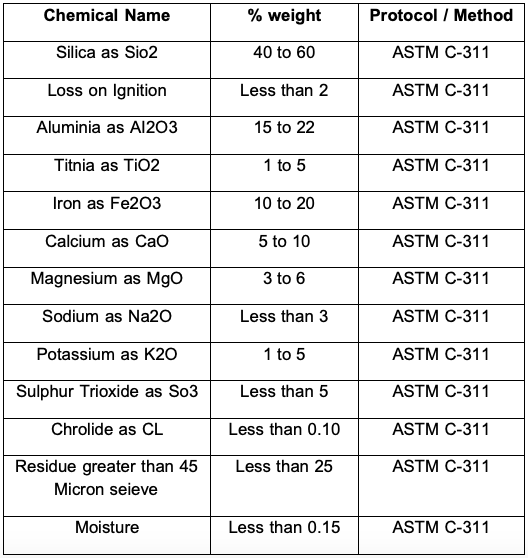SECTION 1. PRODUCT INFORMATION
Product name :- Fly Ash
Chemical Description : Inorganic oxides ( varying from fused or vitrified to fine granularsolid )
Product class : Boilerslag, Bottom Ash, or Fly Ash from coal combustion
SECTION 2.INFORMATION ON INGREDIENTS.

SECTION 3. HAZARDS IDENTIFICATION
=========================== EMERGENCY OVERVIEW===============================
CAUTION! – contact with wetskin may cause severe irritation. Eye contact can cause severe irritation or conjunctivitis. Inhalation of dust may irritate the throat or lungs. Long-term overexposure may reduce pulmonary function ==============================================================================
Primary routes of entry : inhalation of dust . Eye and skin contact. Ingestion of dust
Target organs: Eyes,skin, mucous membranes, lungs, kidney, liver and blood.
Medical conditions: individuals with pre-existing conditions of emphysema or asthma may experience respiratory irritation from breathing dust. Skin conditions or dermatitis may be aggravated by contact with this material.
Potential health effects:
Eye contact: contact with eyes may cause irritation resulting in conjunctivitis.
Skin contact: prolonged contact may result in minor irritation, rash depending on the sulfur trioxide content. SO3 reacts vigorously with water to form hydrosulfurous acid.
Ingestion: ingestion of this product may cause diarrhea or irritation of the mucous membranes of the mouth, throat, esophagus and stomach.
Inhalation : Dust may cause respiratory irritation or fibrosingalveolitis.
Acute / Chronic: Short term exposure can produce dermatitis, horny growths on the skin, conjunctivas, and diarrhea. Long term exposure to fly ash in extremely dusty environments ( above the OSHA PEL) may result in pathology of the nerves in the extremities, blood-forming effects such as anemia, gastrointestinal irritation and cancer of the skin , liver and lungs.
Carcinogenicity NTP: No IARC: Yes (SO3) OSHA: No
SECTION 4 : FIRST AID MEASURES
Eye contact: in case of contact, flush eyes for 15 minutes. Seek medical aid to ensure foreign matter is removed.
Skin Contact : Avoid skin contact with fly ash. Wash skin thoroughly after exposure ceases.
Inhalation: Move victim to a dust-free environment. Support breathing as nevessary.
Ingestion: Do not induce vomiting. Consult a physician.
SECTION 5 : FIRE FIGHTING MEASURES.
Flash point : None
Lower flammable limit : none
Auto-ignition temperature ; none
Decomposition products : none
Extingushingmedia : none required
Fire fightinginstructions : non required
Fire & explosion hazards : none
NFPA RATINGS: Health = 1 flammability = 0, reactivity=0 special hazard=none
Scale: 0=normal material 1=slightly hazardous 2=hazardous 3=extremely dangerous 4= deadly
SECTION 6 : ACCIDENTAL RELEASE MEASURES
Steps to be taken if material isspilled or released: dispose of as conventional waste suitable for a municipal landfill.
Section 7: Handling and storage
Handling : No special requirements.
Storage : no special requirement, material is chemically and thermally stable.
SECTION 8: EXPOSURE CONTROLS / PERSONAL PROTECTION
Personal protective equipment : Eye/face protection: use safety goggles if handling dry powder.
Skin protection : use coveralls and gloves to avoid skin contact with coal sh
Respiratory protection : use a NIOSH approved, high efficiency air purifying respirator for dusty environments that exceed 10 mg/m3 total dust.
Engineering controls : Local exhaust or general dilution ventilation.
Work practices: Do not blow down with compressed air or dry sweep. Use only a HEPA filtered vacuum. Use wet methods or sweeping compound to minimize dust generation.
SECTION 9: PHYSICAL AND CHEMICAL PROPERTIES
Boiling point : not applicable
Vapor pressure: not applicable
Vapor density: not applicable
% volatile be weight: 0
solubility in water: moderate
specific gravity : 2.2-2.8g/cm3
pH: variesfrom acidic to basic dependent upon coal source
freezing point : not applicable
Appearance and odor: Fly ash consists of minute glass spheres with some crystalline matter and varying amounts of unburned carbon. It ranges in colour from light tab or light gray to almost blace depending on the proportions of carbon and iron. Bottom ash is a granular material similar to the fine concrete. It ranges in colour from a medium brown or medium gray to almost black. No order.
SECTION 10 STABILITY AND REACTIVITY
Condition to avoid : none decomposition products : none
Incompatibility : none hazardous polymerization : will not occur
Chemicalstability :stable under normal temperature and pressures.
SECTION 11: TOXICOLOGICAL INFORMATION
On product : Skin corrosion/irritation Not irritant to skin.
Acute oral toxicity LD50 > 2000 mg/kg
Acute dermal toxicity LD50 > 2000 mg/kg
Acute inhalation toxicity Rat LCLo > 200 mg/kg
Multi-dose toxicity : inhalation rat TCLo 15mg/ m3
Irritation : Eye rabbit . 25mg 24 Hours miled irritation
SECTION 12 ECOLOGICAL INFORMATION
Aquatic Toxicity : testing on ash ponds consistently show the effluent to not be acutely toxic in 100% effluent for Ceriodaphniadubia (water fles) and Pimephalespromelas ( fathead minnow).
Environmental fate : nearly all ash is inert upon release to the environment and would be deposited in the sediment. Less than 1% of ash would be dissolved in the water column.
Environmental Toxicity: when handled and disposed of properly, coal ash does not present an environmental threat.
SECTION 13 : DISPOSAL CONSIDERATIONS
RCRA status : This material is not a RCRA listed hazardous waste nor does it exhibit any hazardous waste characteristics
DISPOSAL : Dispose of in a manner consistent with federal,state, or local laws and regulations.
SECTION 14: TRANSPORT INFORMATION
D.O.T. CLASSIFICAITON: not applicable; not a D.O.T. hazardous material.
Section 15. Regulatory information
TSCA : not applicable
CERCLA : contains no known hazardoussubstances.
SARA TITLE III:
Section 302 extermely hazardous substances: none at or above de minimis concentrations.
Section311/312 health and physical hazards: delayed (chronic) health hazard from ling-term inhalation of dust.
Section 313 toxic chemicals: none at or above de minimis concentrations.
SECTION 16 . OTHER INFORMATION
HMIS ratings: health =1 flammanbility=0 reactivity=0
personal protection=B= Safety glasses + gloves
Hazard rating scale: 0=minimal 1=slight 2=moderate 3=serious 4= severe.
While thisinformation and recommendations set forth herein are believed to be accurate as of the date hereof, Phenix Enterprise makes no warranty with respect hereto and disclaims all liability from reliance threon.

 |
|  |
|